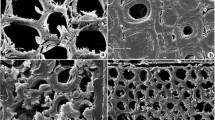Summary
Vinyl polymers in wood-polymer combinations fill cell cavities but do not bond to nor enter cell walls to any noticeable extent. The wood dimensional stability thus remains virtually unchanged. Nonleachable-bulking treatments which react with the cell wall material tend to diminish wood strength properties and do not appear to show promise for providing a link between the cell wall and the polymer. Alkoxysilane coupling agents are widely used to modify the interface between dissimilar materials, such as glass fibers and thermoplastic or thermosetting resins. The coupling agent γ-methacryloxypropyltrimethoxysilane was used in this study with trembling aspen, white birch and eastern white pine woods. Antishrink efficiencies comparable to those reported for reactive chemical wood modifiers were obtained. This treatment did not require acidic or basic reaction conditions which could cause wood strength reductions. Its effects upon wood strength and the extent of bonding to the cell wall are presently under investigation.
Similar content being viewed by others
References
Anonymous, 1980: Selection guide to Dow Corning organosilane chemicals. Dow Corning Corporation, Midland, Mich. Form #23-181C-80
Johannson, O. K.; Stark, F. O.; Vogel, G. E.; Fleischmann, R. M. 1967: Evidence for chemical bond formation at silane coupling agent interfaces. J. Compos. Mat. 1: 278–292
Marsden, J. G. 1970: Silicone coupling agents and primers for thermosets, thermoplasts, and elastomers. J. Appl. Polym. Sci., Appl. Polym. Symp. 14: 107–120
Meyer, J. A. 1981: Wood-polymer materials: State of the art. Wood Sci. 14: 49–54
Plueddemann, E. P. 1970: Silane coupling agents in reinforced plastics. J. Appl. Polym. Sci., Appl. Polym. Symp. 14: 95–106
Robertson, A. A. 1970: Interactions of liquids with cellulose. Tappi 53: 1331–1339
Rowell, R. M.; Ellis, W. D. 1978: Determination of dimensional stabilization of wood using the water-soak method. Wood Fiber 10: 104–111
Rowell, R. M.; Gutzmer, D. I.; Sachs, I. B.; Kinney, R. E. 1976: Effects of alkylene oxide treatments on dimensional stability of wood. Wood Sci 9(1): 51–54
Rowell, R. M.; Moisuk, R.; Meyer, J. A. 1982: Wood-polymer composites: Cell wall grafting with alkylene oxides and lumen treatments with methyl methacrylate. Wood Sci. 15 (2): 90–96
Schrader, M. E.; Lerner, I.; D'Oria, F. J. 1967: Radioisotope study of coupling agents in reinforced plastics. Modern Plastics 45(1): 195–197, 268, 272, 276, 280, 282
Stamm, A. J. 1964. Wood and cellulose science. New York: Ronald Press.
Author information
Authors and Affiliations
Additional information
The authors are grateful for financial support by the Natural Sciences and Engineering Research Council of Canada
Rights and permissions
About this article
Cite this article
Schneider, M.H., Brebner, K.I. Wood-polymer combinations: The chemical modification of wood by alkoxysilane coupling agents. Wood Sci. Technol. 19, 67–73 (1985). https://doi.org/10.1007/BF00354754
Received:
Issue Date:
DOI: https://doi.org/10.1007/BF00354754




